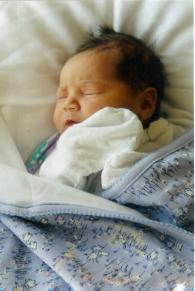
Cognitive
Domain
cd
_____________________________________________Lindsay Robbins

Sensorimotor
Stage of Cognitive Development
Birth
to 2 Years Old
h
”Infants
use their senses and motor actions to explore and understand the world. At the
start they have only innate reflexes, but they develop ever-more
“intelligent” actions and, by the end, are capable of symbolic thought using
images or words and can therefore plan solutions to problems mentally.”
g
(Sigelman,
pg 42,1999.)
Substages
of the Sensorimotor Stage
“Active
exercise and refinement of inborn reflexes”
Example:
Accommodate
sucking to fit the shapes of different objects
“Repetition
of interesting acts centered on ones’ own body”
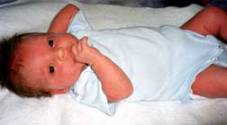
Secondary Circular Reactions (4-8 months)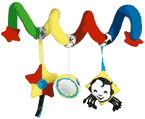
“Repetition
of interesting acts on objects”

Building
Skills With Your Infant or Toddler:
Toy
Websites for the Developing Child
Example:
Repeatedly
shake a rattle to make an interesting noise,
Coordination of Secondary Schemes (8-12 months)
“Combining
of actions to solve simple problems); first evidence of intentionality”
Example:
Push
aside a obstacle in order to grasp an object, using the
Object Permanence:
The
understanding that objects (including people) continue to exist when they are no
longer visible or otherwise detectable to the senses; fully mastered by the end
of infancy.
8
months & Younger:
8
months:
2
years:
Berger, pg. 172, 2003
Tertiary Circular Reactions (12-18 months)
“Experimentation
to find new ways to solve problems
or
produce interesting outcomes”

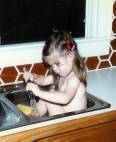
Example:
Explore
bath water by gently patting it,
then
hitting it vigorously and watching
the
results or stroking, pinching, and patting a cat
to see how it responds to varied actions
“Experiments
in order to see”…
Trial
and error with the scientific method…
What happens if…
Beginning of Thought (18-24 months)
“First
evidence of insight; can solve problems mentally now using
symbols
to stand for objects and actions; is no longer limited to thinking by doing”
Example:
Visualize
how a stick could be used to move an out of reach toy closer
L
A N G U A G E

Words Used By Children
Younger than 20 Months:
Sound
Effects-
Food
& Drink-
Animals-
Body
Parts & Clothing-
House
& Outdoors-
People-
Toys
& Vehicles-
Actions-
Games
& Routines-
Adjectives
& Descriptives-
Noises, Cooing, Babbling, & First Words:
Cooing-
(3-4 months)
repeating vowel-like sounds such as “ooh” and “ahh”
Babbling-
(4-6 months) repeating
consonant/vowel combinations such as “dadada” and “baba”
Holophrases,
“First Word” –
(1 year) a single word
that suggests a whole sentences meaning
Parental Encouragement in Language Development:
*Affirmations*
“Yes!
That’s Right!”
*Imitation
of the child’s vocalization*
Repeating
“dog” directly after the child says “dog”
*Describing
objects in child’s surroundings*
“This
is a red ball.”
*Ask
questions to the child*
“Is
that a doggie over there?”
*Play
prompt*
“Why
don’t you put the dolls clothes on?”
*Exploration
prompt*
“What else are we going to do today?”
You Can Talk Baby Talk Too!
http://www.parenting.com/parenting/babytalk/index.html
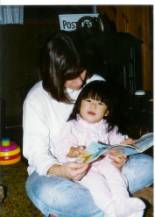
Memory
![]()
![]()
![]()
![]()
![]()
![]()
![]()
![]()
![]()
![]()
![]()
![]()
![]()
![]()
![]()
![]()
![]()
![]()
![]()
![]()
![]()
![]()
![]()
![]()
![]()
![]()
![]()
Contrary to our beliefs that
children ages two and younger can not remember anything, developmentalists now
say that infants can remember numerous events if these conditions exist:
-Experimental
conditions are similar to real life
-Motivation
is high
-Special
measures aid memory retrieval
Tie
a ribbon from your baby’s foot to a colorful (bright colors such as red &
yellow) mobile. Take note when they kick and notice that the mobile moves when
they do this. A week later, again
tie the ribbon to the baby’s foot and mobile and the baby will start to kick
immediately…The Baby Remembers!
Implicit & Explicit Memories
Implicit Memories…
“Memory of events, objects, and
experiences that can be recognized when certain cues are present but cannot be
recalled without reminders.”
…Remembering
the color and texture of your first teddy bear with help…
Explicit Memories…
“Memory that is available for instant recall; often involves material that was deliberately studied and memorized.
…Remembering
your phone number from your childhood house…
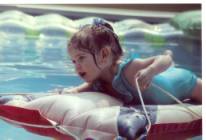
Affordances:
Affordance:
Graspability:
the perception of whether or not an object is of the proper
shape, size, texture, and distance to afford grasping
Visual Cliff:
an illusion of a drop off on a horizontal surface between a child
and his/her guardian
Dynamic Perception: perception that is primed to focus on movement and change
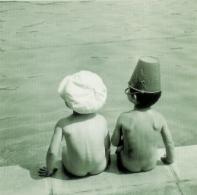
Categorization & Organization:
|
Children under 6 months categorize objects by shape, size, amount (up to 3 objects) and color. | |
|
Children around a year old can distinguish between birds and other animals (knowing that a pigeon is in the same category as a sparrow but is different than a dog), between men and women, children and adults, beautiful people and less attractive people, between dogs and cats. |
![]()
![]()
![]()
![]() SUMMARY
SUMMARY
![]()
![]()
![]()
![]()
To Create the Perfect
Cognitive Domain for Your Infant or Toddler…
v Mobile over the crib with the pictures facing into the crib
v Age appropriate toys that are colorful, have movement, noises, and lights
v Repeating and affirming child’s vocalizations
v Helping children categorize information and objects
v
Repeating events to jog memories
Works
Cited
Berger,
Kathleen S. (2003). The Developing Person: Through Childhood and Adolescence.
New York: Worth Publishers.
Sigelman, Carol. (1999). Life-Span Human Development. New York: Brooks/Cole Publishing Company.